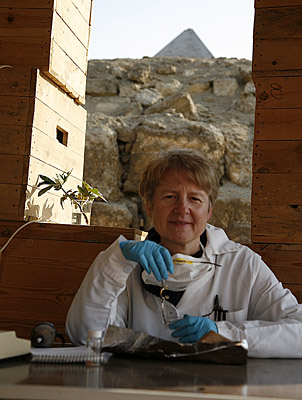Posted by Mary Anne Murray
The Giza Lab season is underway (well, sort of) and, with luck, will continue until May 31st! The events of the past week have meant a slower than usual start to the Giza Lab season actually, however, the specialists are gradually arriving to begin their analysis and interpretation of the material culture excavated from our two sites – Heit el Ghurab (HeG) and Khentkawes Town (KKT).
The Giza Lab, nestled amidst the pyramids, may not look that impressive from the outside as it blends into to the yellowish sand colored landscape of the Western Cemetery. Inside, however, the large rooms are home to the specialist research conducted by our international team of experts whose job it is to recover the stories of our sites from the diverse remnants of pottery, mud sealings, artifacts, human bone, animal bone, plants, chipped stone tools, pigments, plaster, wood charcoal, roofing material, mud brick and the organic residues of food and other remains left behind in pottery and plaster.

The Giza Field Lab (photo - Richard Redding)

Inside the Giza Field Lab (photo - Scott Haddow)
The 2011 cast of characters in the Lab so far includes:
Dr. Val Steele, from the University of Bradford, who is here to analyze the organic residues from plant and animal derived products that impregnated pottery and plaster thousands of years ago. These residues include oils, fats, waxes, resins, tar, bitumen, etc. that may ultimately tell us what certain pottery vessels or areas of a structure may have contained or have been used to manufacture. A subsequent blog will go into how this is done. There are several particular items and areas of interest at Heit el-Ghurab that Val has sampled including the beer jars found in the slots of the enigmatic Pedestal Building in area AA, the plaster from the pedestals themselves, as well as an area of low bins in AA which may have been used for malting barley prior to beer brewing. House Unit 1, the largest house on our site, in Soccer Field West, was also sampled, again to detect for possible areas used for malting/beer brewing. Val also sampled the plastered ‘troughs and benches’ of the Hypostyle Hall, which lies within the stone enclosure wall and may have used for the drying of food, such as fish. The samples remain in our laboratory at Giza awaiting analysis. The results of the analysis will offer another piece to the puzzle of daily life at the settlement.

Val analyzing pottery at the Giza Lab (Hilary McDonald)
Dr. Ania Wodzińska of the University of Warsaw heads our hard working Polish/Egyptian pottery team though her arrival has been briefly delayed. Three of our Egyptian colleagues who specialize in the study of ceramics Mohamed Naguib, El Ham el Tawiel and Mahmoud el Shafei are on hand to sort and identify the pottery from each area of both our sites to give the excavators immediate feedback as it is unearthed.
Dr. Richard Redding is our archaeozoologist studying the faunal remains. He will be finishing his analysis of the animal bones from area AA this season.
Emmy Malak works on the objects from HeG and KKT and is assisting Ana Tavares with this task several days a week this season.
Johnny Karlsson, our human osteologist, studies the human bone from the Late Period burials that were cut into our Old Kingdom settlement of Heit el Ghurab. During this last week, he has used the time to digitize more of the many burials found at the site.
Our photographer, Hilary McDonald, is here to document the various classes of material culture but also to capture the activity and individuals working in the lab to illustrate our blogs, dispatches, end of season reports, annual reports, newsletters, etc.
As for me, I’m responsible for all the specialists/scientists on the team, run the Giza lab and am also the archaeobotanist, studying the ancient plants from our sites. Other members of the lab team will take turns blogging as they arrive and I’ll report back in every now and then for an update.
Here’s to a long and successful 2011 Giza Lab season!
